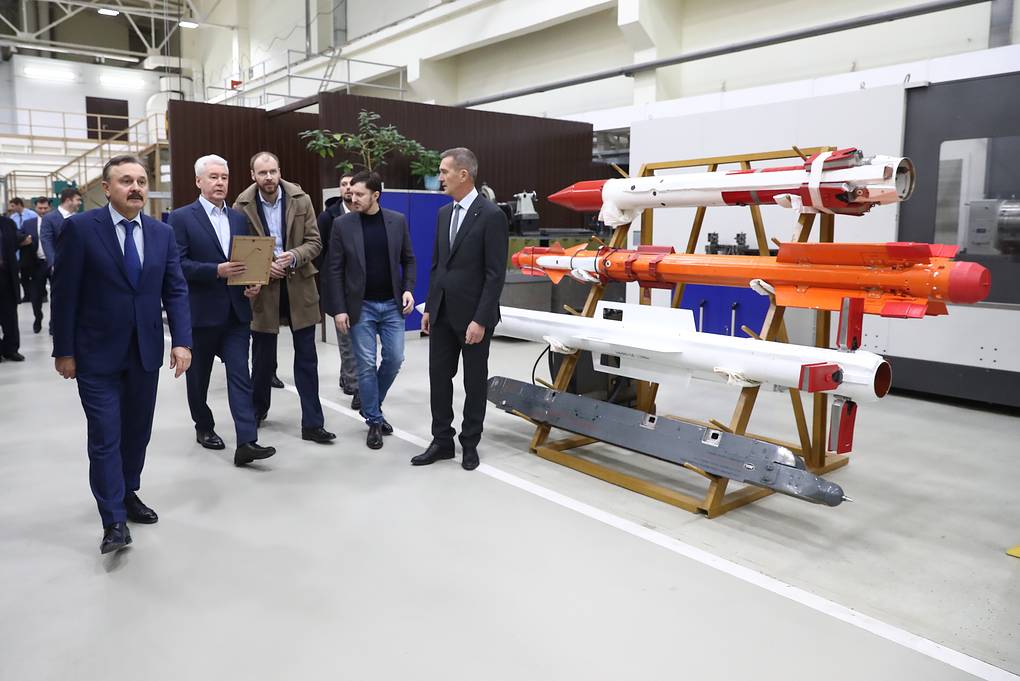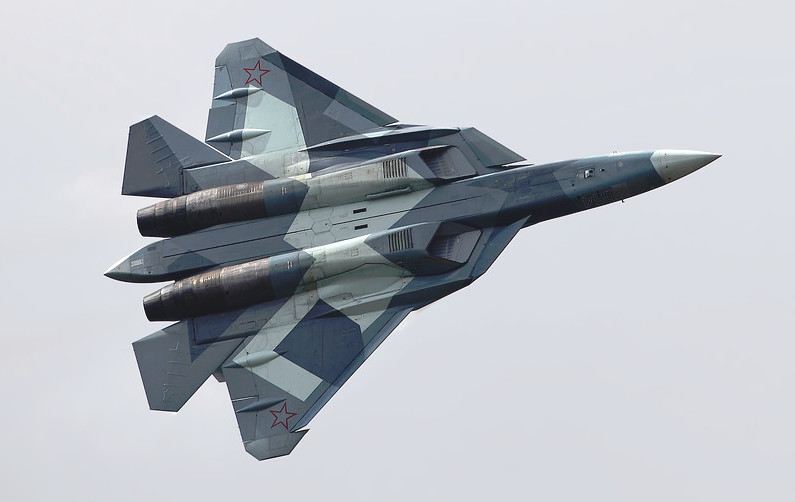Russia is developing a new air-to-air missile that appears to be, at least in part, derived from the medium-range R-77-series. However, it is significantly shorter than any of the variants in that family, as well as the R-74 and K-74M dogfighting missiles. This form factor seems ideally suited to meet space limitations of the small bays located under each of the wing roots of the Su-57 advanced combat aircraft.
The missile, the designation of which is not known, appeared on display at Vympel NPO’s I. I. Toropov design facility in Moscow on Nov. 18, 2019. The city’s mayor, Sergei Sobyanin, toured the site that day as part of an event congratulating the defense contractor on the 70th anniversary of its founding. Vympel is one of Russia’s leading missile makers, specializing in air-to-air missiles, including both the R-77 and the R-74/K-74, as well as the R-73, from which the latter missiles are derived.
“The renovated building will carry out the development and pilot production of almost all types of aviation weapons used for military purposes,” Vladimir Yefimov, Moscow’s deputy mayor, who was also present, told reporters at one point during the tour. He added there had been improvements to just over 193,000 square feet of design and production spaces within the facility.
No specific mention appears to have been made of the new missile, but it is clearly distinct from Vympel’s other known products. From what we can tell, this new design has a diameter that appears close to that of standard R-77, but may be wider. It is also only about two-thirds the length. The R-77 is just under 12 feet long and nearly nine inches in diameter. It is also shorter than the R-74/K-74, which is just over nine and a half feet long.

The rear configuration of Vympel’s new missile is similar, in broad strokes, to that of the R-77, as well, with four grid-fins, but there are noticeable differences. The rear nozzle is wider, which could indicate that it has thrust vectoring capabilities. The compact weapon lacks the strakes along the rear fuselage found on the longer missile, as well.
There is a pointed red cover on the nose of the missile similar to the one found on R-77s with semi-active radar homing. R-77 variants are also available with passive radar homing and infrared seekers and it is possible that versions of this new compact design may come with those guidance options, as well.

What appear to be small apertures for a laser proximity fuze, typically associated with a high-explosive blast-fragmentation warhead, are visible around the body toward the front of the new missile. These types of fuze and warhead arrangements mean that the missile only needs to get within a certain distance of an enemy plane before detonating its warhead, which then sends out a ring-shaped cloud of shrapnel to destroy the target. You can read more about this fuse configuration in this past piece of ours.
So, by a number of indications, this new design appears to be a compact derivative of the R-77 or one that uses a significant number of R-77 components for its design. The most likely application of such a streamlined missile would be as a weapon to fit inside the wing root bays under the Su-57’s wings. These triangular-shaped fairings reportedly have clamshell-like doors that would open to fire a weapon during combat.

As The War Zone, and others, have noted in the past, these have curiously appeared too short and narrow to accommodate Russia’s existing short-range missiles, the R-73 and R-74/K-74. This had seemed to demand the design of a new, compact missile, which has now emerged.
Having a missile that fits in these bays will be important for maximizing their capabilities while the Su-57 remains in its most stealthy configuration. The compact weapon could also help expand the Su-57’s overall magazine depth by allowing it to carry more missiles in its two weapons bays under the central fuselage, which also appear to be relatively space constrained.
You can watch a pre-production Su-57 release a cruise missile from on its fuelsage bays at around 5:30 in the runtime of video below.

The United States has also been exploring similar options to increase the total number of missiles the F-22 Raptor and F-35 Joint Strike Fighter stealth fighters can carry internally for many of the same reasons. In September, defense contractor Raytheon unveiled the Peregrine, a missile derived from the company’s AIM-120 Advanced Medium-Range Air-to-Air Missile, or AMRAAM, but half the size. In the early 2010s, Lockheed Martin has pitched a similar weapon, the Cuda. The U.S. Air Force also has an in-house effort, called the Small Advanced Capabilities Missile (SACM), exploring options for a small air-to-air missile, as well as the Miniature Self-Defense Munition (MSDM), which is focused on developing a miniature air-launched self-defense anti-missile interceptor.
As is the case with Peregrine and Cuda, Vympel’s compact missile could also offer a way for existing Russian fighter jets to increase their magazine depth, as well. Of course, the smaller missiles may have less range or other performance limitations when compared to the full-size R-77 or other larger missiles, but they would still enable Su-57s or other fighters to then carry a greater mix of weapons. If it does turn out that the new missile has the same variety of guidance options as the existing R-77s, it could also allow a single aircraft to have more options for engaging targets using different types of countermeasures or that are stealthy by design.
It’s not clear how long Vympel has been working on this new missile, but the development of the Su-57 stretches all the way back to 2002. There may be new emphasis on the design within the company now that the Russian government has announced plans to buy 76 of these advanced combat jets over the next eight years.
The Kremlin is still actively courting potential foreign partners to join the program and help defray at least some of the costs. Being able to present a more complete arsenal to go along with an export variant of the Su-57, or show that weapons for the aircraft that are still in development are increasingly mature, could help sweeten the deal.
Whatever the case, now that Vympel has publicly shown the missile, hopefully, more details will emerge about its design and capabilities.
Contact the author: joe@thedrive.com
